This is going to be a fun one because today I’m going to do a deep dive into what it takes to rekindle with a fearful avoidant after a breakup.
I’ll be talking about things like,
- The importance of shorter no contact time frames
- Why it’s vital for you to understand the importance of the pendulum swing
- Fearful avoidant core wounds
- Why you need to learn the nurture each of their core wounds
Let’s just get right into it.

What Are Your Chances of Getting Your Ex Boyfriend Back?
Take the quizA Shorter No Contact Time Frame
The first thing you’re going to want to do is initiate a shorter period of no contact.
This is an aspect that not many people contemplate.
The majority of our clients tend to have anxious attachment styles,
While their ex-partners generally display avoidant attachment styles.
They are also typically the ones who are broken up with.
Thus, we’ve discovered that the most effective approach to handle dismissive avoidants involves a longer period of no contact. Yet, this discussion is primarily focused on fearful avoidants, but indulge me for a moment.
Our findings suggest that when dealing with a dismissive avoidant ex, it’s beneficial to extend the no-contact phase.
Here at Ex Boyfriend Recovery, we advocate for three specific timeframes relating to the no-contact rule:
- 21 days
- 30 days
- 45 days.
For an ex who is a dismissive avoidant, providing ample space can prove advantageous.
Therefore, we usually recommend a no-contact period of 45 days.
Fearful avoidants, however, require a slightly different approach.
With fearful avoidants, you need to interact with them similarly to how you would with an anxious ex.
This often means implementing a 21-day rule.
The crucial question now is – why?
Understanding The Nature Of The Pendulum Swing
Well, I believe it all centers around comprehending the nature of the pendulum swing.

What Are Your Chances of Getting Your Ex Boyfriend Back?
Take the quizConsider this: fearful avoidants fundamentally exist on a spectrum – not an autistic one – but a fabricated one that I’ve essentially created for the purposes of this discussion.
Now, imagine that on one side of this spectrum you have avoidant behavior, which characterizes very dismissive avoidant individuals. On the other side, you have anxious behavior.
Positioned right in the middle are the fearful avoidants.
However, fearful avoidants are somewhat different.
Based on circumstances, they can swing from one extreme of the spectrum to the other. They can exhibit remarkably dismissive avoidant behavior one minute, and then a situation may arise that triggers their anxious side, causing them to swing towards the anxious end of the spectrum. Thus, they essentially leap from one core wound to another.
If you’re unfamiliar with the concept of core wounds, I should clarify. Though I’ve discussed these, I can’t claim the originality of the concept. The first time I encountered this explanation was during an interview with our very own coach, Tyler.
He essentially posited that every insecure attachment style is associated with several core wounds.
- An anxious attachment style’s core wound revolves around the fear of abandonment.
- On the other hand, an avoidant or dismissive avoidant’s core wound is a deep-seated fear of losing independence.
Fearful avoidants are unique because they bear both core wounds.
This is where the constant shift from one end of the spectrum to the other comes into play. This fluctuating behavior can be incredibly confusing for many people. This is frequently observed in fearful avoidants, where their behavior is notably hot and cold. In fact, some might misinterpret them as having a multiple personality disorder because it may seem as though you’re conversing with different people.
But there’s an aspect of fearful avoidants that often goes undiscussed. We understand their tendency to oscillate from one end of the spectrum to the other – that pendulum swings back and forth from the anxious side to the avoidant side and so forth.
The reason we advocate for shorter periods of no contact is that if the anxious core wound is triggered and not nurtured, the fearful avoidant might retreat into the dismissive avoidant core wound and remain there for an extended period.
Imagine that you’re implementing a 45-day no-contact rule with a fearful avoidant, and you’re entirely convinced that this is the correct approach.
Often, when a fearful avoidant breaks up with you, they’re triggered on their dismissive avoidant side.
But perhaps something during your 45-day no-contact period triggers their anxious core wound.
Instead of nurturing this wound, which isn’t always necessary and may sometimes be ideal, you inadvertently push them further into their dismissive avoidant core wound.
After that it may take significantly longer for their anxious side to be triggered again.
What Is Really Working In The Field On Fearful Avoidants (Hearing From Real People)
So, the real question is, how do you manage a relationship with someone this complex?
This question was literally posed in our community today:
The poster asked,
“How do you handle a situation where your fearful avoidant won’t admit they want you back, even though their actions suggest otherwise? I suspect that if the roles were reversed, I wouldn’t be able to voice it either. I want to take things very slowly, but how can I avoid a situationship?”
Essentially, this person is asking how to cope with a fearful avoidant.
I was genuinely impressed with the responses our members offered.

What Are Your Chances of Getting Your Ex Boyfriend Back?
Take the quizThe first one essentially advised,
“Prompt them to admit it by not chasing. If they want it, they will eventually overcome their fear.”
A few others proposed the contrary, stating,
“Stay close to the fearful avoidant, be present, but do not push them towards a relationship in any way, not even subtly. Allow them to experience longing for you initially and remain nearby for when they muster up the courage to make a significant move towards you.”
I really appreciate the latter suggestion, but fundamentally, both responders are correct.
The first comment suggests providing space, while the second promotes being present.
Both are valid strategies, perfectly encapsulating the principle of reciprocating their pull-back with your own.
One thing I usually don’t discuss with this principle is the importance of closeness when they’re not pulling away, of being present in the moment.
Throughout the history of Ex Boyfriend Recovery, I’m known for advocating the mantra:
“When they pull back, you pull back.”
However, I rarely address what happens when they don’t pull back, as few people inquire about the good times. It’s vital to be present in those moments.
Giving Each Core Wound What It Wants
To put it metaphorically, this approach is about catering to each core wound’s needs.
It’s akin to planting a seed and watering it over time.
- For the avoidant side, they desire space, so provide them with that when their avoidant side is triggered.
- For the anxious side, they crave nurturing, which, in this context, means being present, being in the moment, and not trying to fix their problems.
I think this is where most people stumble.
When I say “nurture the anxious core wound,” it’s often misconstrued as trying to fix the issue or make the person feel better. However, nurturing in this context simply means being present, as the earlier respondent mentioned.
The fascinating aspect is that if you’re catering to each core wound’s needs consistently, over time you’ll start to see the fearful avoidant showing interest in rekindling and taking the next step.
It’s akin to both planting a seed and watering it, and fishing.
One of my earliest memories of fishing involves my grandfather taking me to a pond and teaching me the ropes.
Like any typical kid, I would cast the line, feel the bite, and immediately start reeling in with all my might. But if you reel in too forcefully, what happens? The line snaps, and the fish gets away.
If, however, you reel in a bit, then pause, giving the fish some slack, and then continue this pattern, the fish gradually tires out and allows itself to be reeled in.

What Are Your Chances of Getting Your Ex Boyfriend Back?
Take the quizThis is the approach you need to take with a fearful avoidant. Instead of reeling the fearful avoidant in, you’re nurturing their core wounds.
Part of this strategy also requires you to be very aware of when their core wounds are getting triggered.
If you notice they’re suddenly distancing themselves, their avoidant core wound is likely triggered, and you need to give them space. If they’re seeking constant reassurance, acknowledge it, provide a bit if you can, nurturing their anxious core wound.
If you adopt this approach, I promise you’ll start to see improved results with your fearful avoidant ex.
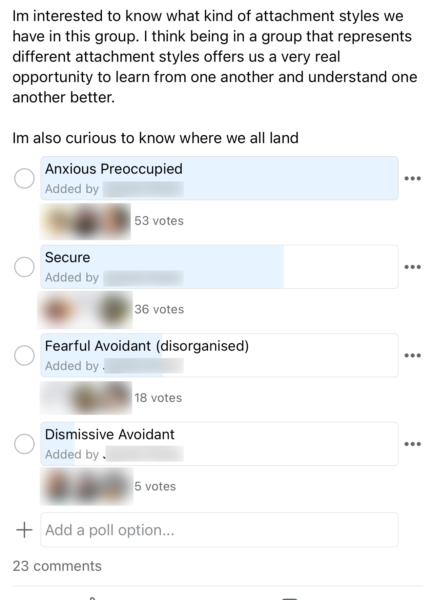
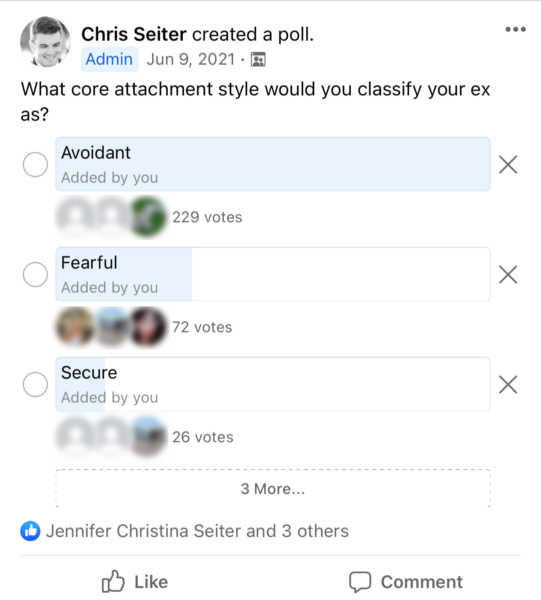
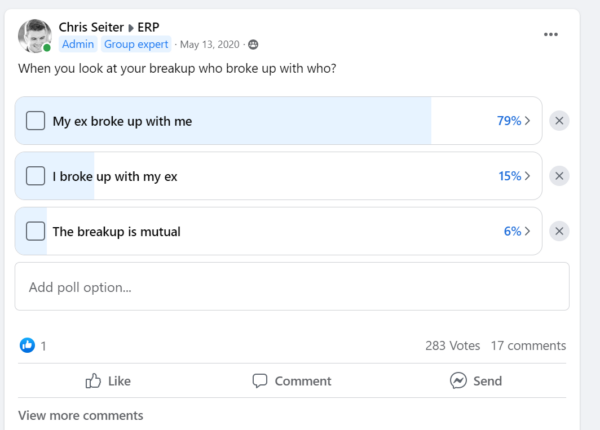
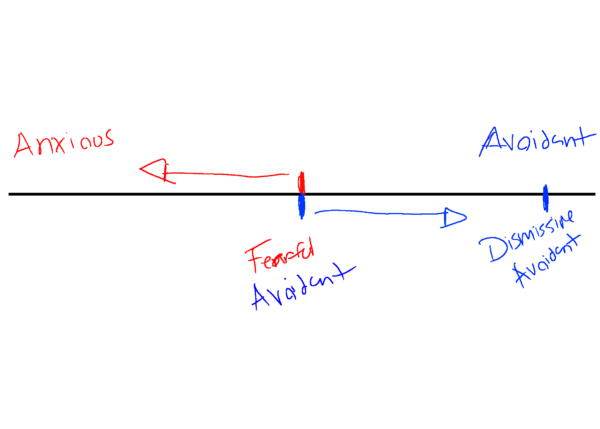

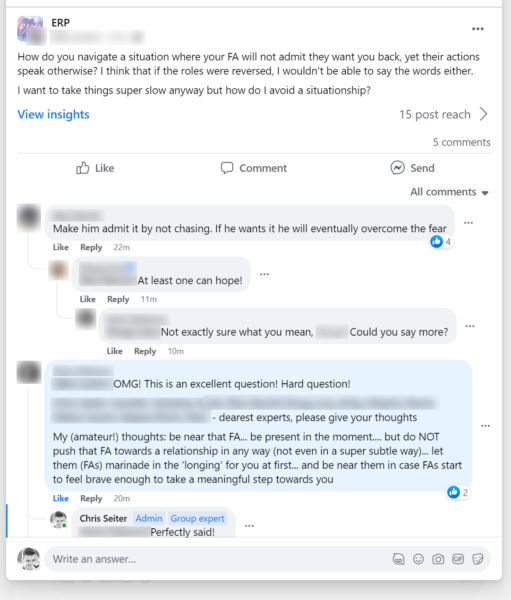
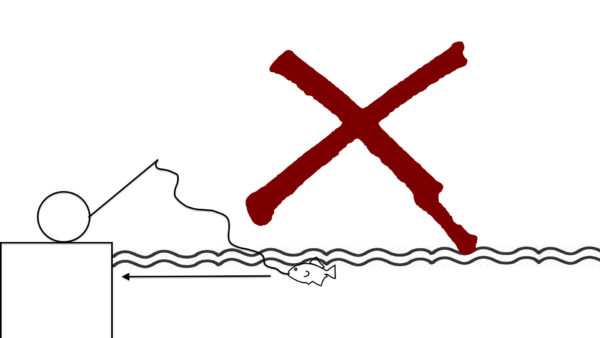
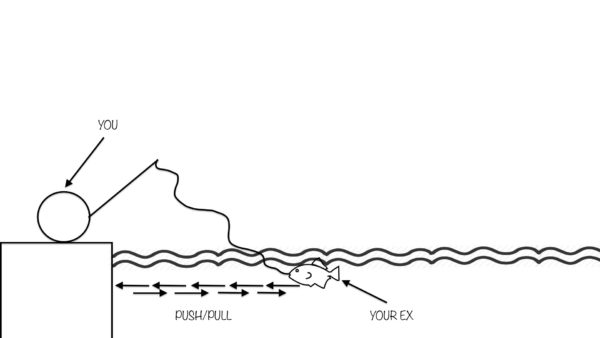
Ann
January 26, 2025 at 3:07 am
Hi Chris
I reached out to my FA ex after 7 months as he had some things to sort out. After 17 days he replied. We texted regularly and planned on meeting up but he cancelled. After that our convos became a bit deeper and more open. We text most days now and he sends kisses and gives a few compliments. I said I would love to meet up in the next few weeks and would respect his boundaries. He thanked me for understanding and said a couple of weeks would be good. I doubt he will initiate the meetup but I also don’t want to pressure him. What would you advise?
R
January 18, 2025 at 9:53 am
Hi, I bumped into my ex last week, it was the first time we’ve really spoken since the break up and we had a nice chat and catch up. Before he left he got a bit emotional and said he would ‘try’ to be in touch. Would 21 days be a good time frame to give him to ‘try’ before teaching out to him myself? Now that the ice has been broken I don’t want it to freeze over again.
R
January 16, 2025 at 4:14 pm
I bumped into my FA ex last week, we had a good chat and catch up. Towards the end he got a bit emotional and said he would ‘try’ to be in touch. Would 21 days be a good time frame to give him to ‘try’ before reaching out myself? Now the ice has been broken I don’t want it to freeze over again.
Yasmin Meza
December 23, 2024 at 10:43 pm
My fearful avoidant ex dumped me a month ago. I begged for two weeks right after the breakup. But one day I decided to stop reaching out as soon as he noticed that he texted me the he loves me and misses me. He continues to text me everyday since light engaging conversation, but then I ask him if he wants to get back together then he says he wants to be alone right now but he’s thinking about us. Would no contact help at this point?
Rebecca riehl
November 15, 2024 at 2:53 am
Just want the blog access. How much is that. After the 6th time of this I am so depressed
Chris Seiter
November 28, 2024 at 5:00 pm
Our website is free to use. If you need some additional help, just reach out to our Support email and we will get you pointed in the right direction.
Nikki
August 26, 2024 at 10:14 pm
I am sooo confused. My ex is a fearful/dismissive advoidant. I just can’t work out what to do? I’m currently 2 weeks into no contact but after reading this wondering if I should reach out??? He’s long distance. . Or juwt leave it be :(?
Esse
July 31, 2024 at 7:42 pm
Assuming this would “work”, what kind of relationship would I put myself in? A lifetime of paying attention and reacting to his needs with very little space for mine? The issue is that when you’ll go through some difficult times (and we all do every now and again), feel stressed and need to rely on them, they’ll get triggered and and run away. If you let your guard down for a sec and relax in the relationship and be yourself, they’ll get triggered and run away. It is unthinkable to implement such a complex strategy over a lifetime. The other issue is that often, when their avoidant side is triggered and they pull back, they’ll turn to other women, alcohol or anything that will make them feel “free and independent”. I have given five years of my life to a fearful avoidant who has both promised me world and performed grand love gestures and broke up with me multiple times, always when I was fragile and needed someone to rely on. I have been in no contact for three weeks now, and I am starting to see how such a complex strategy can’t work in the long term. At some point he’ll need acknowledgment of his attachment issues and years of therapy, and goof luck getting someone like that to take a look in the mirror or admit to anything. My experience is/was with one person only, but I did read this website and follow the advice to a t, only to realise that it is not a sustainable strategy in the long term, at least not for me. I refuse to enslave myself to someone else’s attachment issues.
Ondine
July 20, 2023 at 12:59 pm
Hi Chris!
My ex is a fearful avoidant and we were also long distance. Because of that fact I implemented a 30 NC but I’m wondering if because he’s fearful avoidant should I lower it to 21 days.
Hoping to hear back.
Coach Shaunna
October 21, 2023 at 11:25 am
Hi Ondine, 30 days is fine as you are already LDR